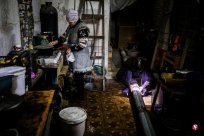
International Special Special
As people gradually come out of the crown disease, the tourism industry has begun to recover quickly. Southeast Asia's tourism industry has been silent for more than two years, just to give the industry the opportunity to promote sustainable tourism. What are the reasons for steering sustainable travel in Southeast Asian countries, and what challenges may they face in the future?How can tourists practice sustainable travel?
Before the outbreak of the crown disease, Southeast Asia was one of the fastest growing regions in the world.
According to data from the Asian Development Bank, in 2019, Southeast Asia received 13,700 tourists and nearly 1 billion domestic tourism trip. The tourism industry accounted for 12.1 % of the GDP in Southeast Asia, and about 42 million people engaged in tourism work.
However, the rapid growth of the tourism industry will cause environmental problems.For example, between 2011 and 2017, the number of tourists from Boracay Island, a Philippines, increased by 160 %.Receive tourists to breathe the environment.
Asia Danian realized that the poor planning and management of the tourism industry will have a negative impact on the local communities and the environment, and it has begun to promote the sustainable development of tourism in tourism.For example, the vision of the Yajian Tourism Strategy Plan (2016-2025) is: "By 2025, Asia will become a high-quality tourist destination ... and is committed to promoting the development of responsible, sustainable, inclusive, and balanced tourism, it will be Southeast AsiaThe people's social and economic well -being has made significant contributions. "
Promote passengers to experience low -carbon activities towards sustainable tourism direction
What is sustainable travel?Scholars point out that the principles of sustainable tourism include the interests of economic growth, environmental protection and balance.
Melinda Martinus, chief researcher at the Easov Issa East South Asian Research Institute in Singapore, said in an interview with Lianhe Morning Post that sustainable tourism is to take the needs of the local community as a priority consideration to promote passengers in low carbon footprints and low -carbon footprints andIn the experience of social consciousness activities.
Simple examples, encourage tourists to use land public transportation such as trains instead of aircraft to reduce carbon emissions. Choose to dine on local restaurants instead of patronizing buffet restaurants, or avoid using grooming supplies provided by hotels to reduce plastic garbage.
Asians' Southeast Asian development solution knowledge and innovation platform pointed out in an article entitled how Southeast Asian countries should turn to sustainable tourism, although the crown disease epidemic has caused tourists in this region to fall by 82 % in 2020,However, it provides a rare opportunity to make the tourism industry better reshape and move towards the direction of sustainable tourism.
The major tourism country in this region has launched sustainable tourism strategies.As early as 1996, Malaysia launched a general blueprint for ecological tourism, taking the first step in sustainable tourism.The Prime Minister of Thailand launched the "SMILE" strategy in June this year -emphasizing comprehensive sustainability, improving the level of manpower, promoting tolerance economy, promoting local characteristics, and protecting the ecological environment to ensure the sustainable development of Thailand's tourism industry.
The Minister of Tourism and Creative Economy, Sandidiaga, recently pointed out at a seminar that Indonesia is shifting from Volkswagen to ecological tourism and sports tourism, and is committed to promoting nature and culture to tourists.
to let different interest parties reach consensus is the biggest challenge to the sustainable tourism industry
Experts and scholars believe that although the trend of steering sustainable tourism in this area is positively developing, it is facing many challenges.
Steven Schipani, chief tourist expert of Southeast Asian departments, believes that one of the biggest challenges is to allow different interests to reach a consensus on the common vision of sustainable tourism when tourism starts to recover.
He said: "I think the government, private sector and other related parties must communicate with each other to determine that all parties can interact with sustainable interests and cooperate for common goals."
Matinas bluntly stated that it has not yet seen a comprehensive overall plan for countries in this region, pushing the tourism industry in the direction of sustainable development.
She pointed out that people generally believe that more passengers should be attracted as much as possible, and many performance indicators in the tourism industry should still be around the number of tourists or how long to stay."If we can change this concept, turn to high -value tourism, attract less tourists, but provide a more immersive local travel experience to collect higher travel expenses, and the country can still create a lot of tourism revenue."
But she admits that it is quite challenging to formulate such a plan, because "countries must ensure that domestic attractions have unique selling points than opponents, and it is a very rich experience for tourists."
Schipney emphasized that countries must shift to sustainable tourism, which requires more environmentally friendly infrastructure, more skilled manpower and attractions managers, and regulations and policies that inspire people to operate more sustainable ways.
Matinas said that Southeast Asia has not been fully connected through highways and high -speed railways. She hopes to see more related infrastructure investment in the future as a low -carbon travel method.
The focus of the Southeast Asian Research Institute in March this year to discuss how to promote the sustainable tourist tourism of Asians, and the crown disease epidemic provides opportunities for countries to test and improve sustainable tourism development plans."Strict environmental protection regulations, such as restricting plastic garbage and punishing the environmental behavior, it is necessary to shape the new habits and behaviors of residents and tourists."
"Do your homework" before traveling to master information and physical strength
Singapore tourist Ye Xiaozhong believes that tourists pay attention to the pursuit of personal philosophy when practicing sustainable tourism.Those who want to support sustainable travel are the most important thing is that they must "do my homework" before traveling, consciously understand information in this area and do their best."Tourists must know how to choose, or not want to pay more to learn more about sustainable tourism options, and even choose to be slightly expensive but supporting sustainable tourists."
He said that tourists can take the initiative to learn about activities and attractions that adopt sustainable tourism policies, and which hotels to truly promote sustainable tourism, not just labeling on the "sustainable" label, but still provides once provided once.Sexual supplies or bathtubs.
As for more Southeast Asian countries seeking shift to attract "high -value tourists", Ye Xiaozhong believes that "the direction is right in this direction", because high -value tourism means that the number of tourists is relatively small, which will help reduce the environment for the environment.destroy.
He does not think this strategy will lead to lowCounting less tourist destinations that tourists can choose in the future, because whether it is a hotel or attraction, most countries will have "replaced options for low budget tourists."
Establishment of waste research room Bali Island Hotel Development Environmental Protection Products
The government plays an important role in formulating sustainable tourism development planning, and the efforts of tourists are indispensable.
DESA POTATO Head, a resort in Bali, Indonesia, adopted the concept of "zero waste design" with environmental protection as the first business policy.
AMANDA Marcella (34 years old), the hotel's sustainable development director, said in an interview with Lianhe Morning Post that the founder and son of the hotel surfed in Bali in Bali in 2017 and found that the sea was piled up at sea. Realizing that the hotel industry should be the environmentProtect a point.
Since 2017, hotels have banned residents and suppliers from using disposable plastic products, and also set up a exclusive team to develop various environmental protection products.Boxes, chairs and other hotel supplies can be reduced as much as possible.
Amanda said that more than a year when the hotel was closed during the epidemic, he also vigorously developed the process of environmental protection.They established the "Waste Research Office" in 2020 to be responsible for garbage classification management and development of environmental protection products.In the first half of this year, the hotel had been cyclically about 500 kg of plastic.The team also made the use of edible oil into candles.
Amanda admits that the implementation of this environmental protection policy will also face challenges -insufficient materials."Now everyone is very concerned about these recycling materials. Sometimes the materials collected by the hotel are insufficient, and when there are many homework completed, we must spend additional money to buy materials."
Seeing the vast majority of residents has a high degree of acceptance of this environmental protection concept, and generally gets positive feedback, I am encouraged by Amanda and the team.
Amanda revealed that the hotel plans to introduce renewable energy in the first half of next year to produce sufficient electricity for the operation of the waste research room by installing solar panels.
Natural disaster impact regional tourism industry
In recent years, severe disasters have occurred in countries in the region, which has impacted the local tourism industry.
Thailand is often listed as one of the most vulnerable countries in the world.In October of this year, floods in many cities such as Capital Bangkok, and Chiang Mai, a popular tourist destination in the north, was overwhelmed, hindering the recovery of tourism.Commercial, industrial and banking joint committees estimate that severe floods have led to a loss of up to 10 billion baht (about S $ 386 million).
The seasonal storms in Bali, Indonesia caused floods and landslides in October, causing at least six people to die.The Philippines was attacked by a tropical storm in the same month, causing 150 people to die, and local agriculture and infrastructure suffered a lot of losses.
According to the global climate risk index of 2021 by the research institution "Observation of Germany", in the 20 years from 2000 to 2019, Myanmar, the Philippines, and Thailand are the top 10 countries with a long -term impact of climate change.
Climate change is also closely related to human health.The World Health Organization estimates that from 2030 to 2050, climate change will cause more than 250,000 people to die due to malnutrition, malaria, diarrhea, and thermal stress.
Another major health threat is food shortage.According to a report released by the willow of the Liuye knife in October, compared with 1981 to 2010, the number of people facing severe food in 2020 increased by nearly 100 million people.
Therefore, promotion of sustainable tourism not only affects tourism income because climate change may affect tourism income, but also for the long -term benefits of human beings.
The number of measures to control tourists from various countries
In the South Asian inland small country, Bhutan has experienced a retreat of the country for more than two years during the epidemic. In September this year, the country was reopened to welcome foreign tourists.
Bhutan officially increases the sustainable development fee, and tourist taxes have increased from $ 65 (about S $ 89) to $ 200 per night. This is one of the "high -value, low -person" tourism strategies.
Foreign Minister and Chairman of the Tourism Commission, Dorgi, said in a statement: "The epidemic of crown disease allows us to reintegrate how to build and operate the tourism industry ... while maintaining low -carbon footprints." Local officials said that these expenses will be used to plant trees and afforestation, improve the human skills of tourism, reduce dependence on fossil fuel and use electric vehicles to offset tourists' carbon footprints.
Turn your eyes to Italy."Water City" Venice was born of water and is beautiful due to water, but climate change makes the seasons more tricky.In 2019, the worst flood in Venice has occurred in half a century.A large number of tourists led to sinking in many local buildings, or the surf of waves aroused by the water dog.The rising sea level is more likely to cause Venice to be drowned by the sea in 2100.
The Italian government first proposed the Moses flood dam in 1992, hoping to save Venice.The dam system will not be completed until next year, but after the use of 2020, it has begun to play a role, allowing Venice to escape a serious flood.
In addition, the Italian government also controls the problems caused by excessive tourists from many aspects, including prohibiting large cruise ships from approaching the canal and squares of Venice from last year, encouraging the use of electric vessels as water dodges, limiting speedboat speed, and starting to tourists from next year.Get charged in the city.




